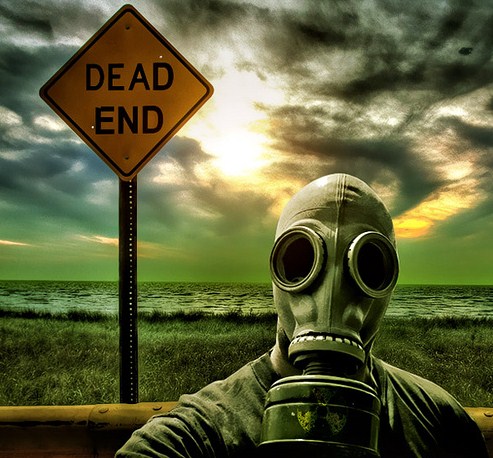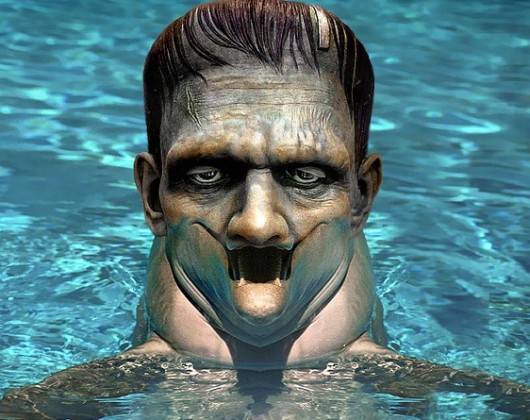Should the US Constitution’s Domestic Violence Clause Be Applied to Environmental Issues?
Michael Diamond was a general practice lawyer in Union County, New Jersey, before a brief career change in 1981 when the newly-created Division of Water Resources in the New Jersey Department of Environmental Protection (NJDEP) was looking for an Enforcement Administrator and Chief Regulatory Officer. Diamond accepted the position and was effective at applying his legal skills to create new enforcement techniques for the department. Having received no formal training from the DEP or its overseers at the Environmental Protection Agency (EPA), Diamond realized that he was surrounded by other lawyers and engineers but no scientists or health officials. He began to ask why there were no microbiologists, botanists and professional health people there to study the connection between environmental exposure and illness. After a year, Diamond was cycled out of the position and returned to his law practice. This time, he applied what he had learned at the NJDEP to his law studies and began looking for a remedy that would bring Americans back to health and sustainability to the Earth. On study of the Constitution of the United States, he realized that the wording of The Domestic Violence Clause, in Article IV, Section 4, could apply to environmental issues. Diamond has written several essays and a book titled If You Can Keep It: A Constitutional Roadmap to Environmental Security on the topic of this overlooked constitutional clause. I had the privilege of meeting Michael Diamond last year and learned about his crusade firsthand. We recently sat down together for an interview.
Andrea Egizi: Why do you think the EPA and DEP did not hire health professionals to research the effects of the environment on the very people they were trying to protect? How could they have made decisions about risks, let’s say concerning pollutants in potable water from a well?
Michael Diamond: Exactly. The closest they came to assessing risk was to search the published literature and determine whether any of the contaminants caused cancer.
A.E. And you found that disquieting because…?
M.D. Because there are an array of illnesses caused by exposures that don’t lead to cancer but are nevertheless damaging. And to make matters worse, the engineers were unable to assess the amount of exposure that might be harmful to children.
A.E. So, it’s fair to say that they were flying blind?
M.D. Without question. But don’t get me wrong, the engineers were wonderful, hard working people. It was just that the system had been set up to overlook the real health effects of exposures in the country. And the system wasn’t just wrong, it was Kafkaesque. The engineers would say that certain chemicals were okay to be in the drinking water because they were not carcinogenic; they were only mutagenic.
A.E. Stop me if I’m wrong, but if a chemical is mutagenic, doesn’t that mean that it’s dangerous in that it creates mutations that can be harmful?
M.D. Absolutely. Exposures to a mutagenic chemical can create birth defects, damage DNA, and end up causing cancer. But there’s something even more troubling about reliance being principally on published scientific journals to determine whether a particular exposure caused cancer or not. The scientific journals themselves were and remain biased in favor of the producers and users of chemicals. You see, scientific research, to the delight of the corporations, requires that each contaminant be shown, by itself, to cause cancer. And environmental laws in the United States have codified that requirement. In effect, chemicals have been treated as though they are individuals presumed to be innocent unless and until proven guilty by rigorous scientific research.
A.E. Now, that doesn’t accord with reality because…?
M.D. Chemicals are never experienced by people individually. There are multitudes of them within all of us. We’ve been inundated by exposures since the mid 1940s. In fact, chemicals interact with one another, and that interaction can and does augment the harms that they do to us. In addition, each of us is unique. What may be insignificant to one person can be a tipping point into disease for another. To treat chemicals as innocent until proven guilty, as if they were individuals with due process rights is wrong and dangerous. And the worst part is that children are so very vulnerable. If there had been even one microbiologist present, he or she certainly would have been able to express the truth that exposures during critical developmental times, even though slight, should have been considered harmful and dangerous. A minute exposure in utero, for example, could easily cripple a developing immune system. And a similar minute exposure at a critical juncture in the development of a young growing brain could readily condemn a child to difficulties in learning and impulse control.
A.E. But certainly, in the 30 years that have passed, hasn’t the environmental regulatory system caught up to the reality of current environmental threats?
M.D. In a word: No. Researchers, for example, in a futile effort to find the alleged single cause of autism, remain stuck in the stupid maze created by our environmental laws. They’re not likely to find one single cause for the disease because the causes are multiple, interacting, and may be occurring in a flash of tiny exposures during a particularly susceptible span of moments in a child’s early development. Autism used to occur once in some ten thousand births. Now, in some states, it’s occurring once in less than every forty births.
A.E. And other diseases?
M.D. Cancer used to be rare in adults and even rarer in children. Now, it’s showing up in roughly half of the American population. And cancer in children is now so common that there are pediatric oncology units in major hospitals. Babies, eighteen months of age, are being diagnosed with brain tumors. But cancer and autism are not the only rising diseases. Asthma is showing exponential growth, and food allergies are threatening children’s lives in a manner that has never happened before. At present, schools have to be prepared to administer a life-saving antidote when an allergic child is exposed to peanut butter.
A.E. Talking about children, I can’t help thinking about whether we’re leaving to them a world that will not be sustainable.
M.D. Yes, I’m with you there. Global climate changes are real and observable. Acidification is undermining food chains in the oceans, and that’s occurring as we speak. Unless we get to changing things fast, this planet will begin a cycle downward toward being uninhabitable. Wars for declining resources have already begun and are destabilizing large populations.
A.E. So tell me, what solution do you think will work?
M.D. When I left the state environmental department, I began searching for a remedy that would bring Americans back to health and bring sustainability to the Earth. One of the documents that I studied was the Constitution of the United States. I studied the Constitution in law school, but that clause was never mentioned. Most lawyers never heard of it. There hasn’t been a major legal case on that provision for over a hundred years. So, it doesn’t make its way into case-oriented legal textbooks. But when I started to look at that provision, I realized that it was the ideal remedy for us because the Supreme Court has repeatedly held it to be a people’s clause. All this meaning that if and when we ever get to the point where we are harming ourselves and each other in significant ways that are beyond the police powers of the states to handle, then it’s the responsibility of the federal government to step in.
A.E. How is it that American industry was allowed to conduct a massive chemical assault upon us and our children with outrageous consequences?
M.D. The year 1945 should have been the beginning of a better life for everyone on this Earth. Instead, on the death of Roosevelt, his then Vice President was Harry Truman. Truman, instead of respecting the Russian war effort that was the prime reason for the military defeat of Hitler’s Germany, declared America’s undying opposition to communism and demanded its defeat whenever and wherever it surfaced in the world. Thus began the Cold War in which Truman tapped the American business community to be our avatars in the fight to bring goods and services to a world in need. Our manufacturing know how and technical competency were to bring an end to poverty and ignorance. And by doing that, Truman believed, we would bring an end to what he described as Godless and evil communism, forever. Now, relating this to the environment, neither Truman, nor the presidents to follow him had a mindset to regulate industry. Industry was our newly knighted warrior. Manufacturing was going to enrich, not bring harm, to the world. And that was the mindset that kept the American government from doing what governments were supposed to do: protect the people from harms, both internal and external.
A.E. Corporate power at this time must, in fact, be confronted in order to assure survival. Is that what you are saying?
M.D. Exactly, and the person who said it best a long time ago was Supreme Court Justice, Louis Brandeis. In a 1933 case, Liggett v. Lee, he said that it had been a mistake to give corporations the rights of citizens. They were anything but citizens. Their sole purpose was to bring financial returns to shareholders. In the process of accomplishing that, they would limit freedoms and diminish human happiness. Brandeis called them “Frankenstein monsters.”
A.E. How could the domestic violence clause limit corporate power?
M.D. The domestic violence clause contains war powers. Let me repeat. That provision contains war powers to be used in peacetime to assure our survival. War powers can be used to revoke and revise corporate rights and prerogatives. The domestic violence clause, because it entails war powers, can require that corporations abide by strict requirements that are necessary in an emergency.
A.E. An example?
M.D. Certainly. It didn’t matter if you were the biggest automobile company in the world in 1944. The American government at war directed you to make trucks and tanks, and that’s what you did. Every corporation in the United States was commandeered. Indeed, the entire economy was commandeered by the federal government under emergency war making powers in the Constitution until there was victory. The domestic violence clause entails the same powers.
A.E. Alright, so what could the federal government do now, using the powers of the domestic violence clause, to safeguard people?
M.D. All of the things that must be done to assure our survival. Expenditures for war must end. All of our resources must be used to heal the sick and stop the exposures. Agriculture has to be made organic, with crops coming from family farms again, instead of from feedlots and corporate monocultures. Our healthcare system would be commandeered to change the focus to preventive actions and intensive work with those of us who have been affected by exposures. Insurance companies will need to be taken out of healthcare and their personnel be trained and put to work elsewhere in a new health-delivery system. The stranglehold that pharmaceutical companies now have on health choices will be stopped and broken. Enormous efforts will need to be put into education so that our children are no longer burdened by the consequences of exposures and can get back to performance levels preceding the 1970s. That’s just a small glimpse of what can be done.
A.E. So how could this clause be put into action?
M.D. We create a movement and a new political party, if necessary, by telling Americans who are suffering from diseases and disabilities as never before that their plight and the plight of their children and grandchildren is not a matter of bad luck, bad genes, or God’s will. Our ill health is the result of harms we have brought down upon ourselves, beginning with the chemical age that we created at the end of the Second World War.
E.A. And Americans will listen to this message?
M.D. As never before. That’s the one benefit to experiencing a total defeat. Corporate America has overplayed its hand. Not satisfied with efforts to own all seeds through genetic engineering, they are now producing genetically modified fish. People are beginning to think of that nasty experiment as Frankenfish, a product conceived and made by Justice Brandeis’s Frankenstein monsters. In short, Americans are health conscious and are ready to hear that we’ve been duped. Americans understand now, as never before, that all of our institution, from financial, through business and manufacturing, need to be reconfigured to serve the needs of the people and not just those whose purpose in life is to engorge themselves with power and money.
E.A. So a political effort begins how?
M.D. By contacting our state government representatives, members of the fifty state legislatures. Families suffering from cancer, asthma, autism, and the host of learning and attention deficits need to contact those representatives and do it regularly. The state legislators should be asked to tell the federal government that a condition of domestic violence exists in all of our states and it requires the federal government to bring us back to health and assure our survival.
E.A. And, as I understand your essays, you have a special job for our elders, do you not?
M.D. Yes. Those of us who were born before 1940 remember a time when cancer was rare and no one knew anyone who suffered from autism. Learning was easier then, and civility was the rule. I think we ought to call upon those of us who were born back then to testify as witnesses that the modern diseases and disabilities were brought about as a result of trading health for corporate profits.
A.E. Well, I get the sense that what you’re saying can happen.
M.D. I’d say it’s worth a try? Andrea, thanks so very much for listening to all of this. I so very much appreciate your attitude of respect for new ideas.
Editor’s Note: All composite photographs by Mark Rain.
Related Articles




















You must be logged in to post a comment Login